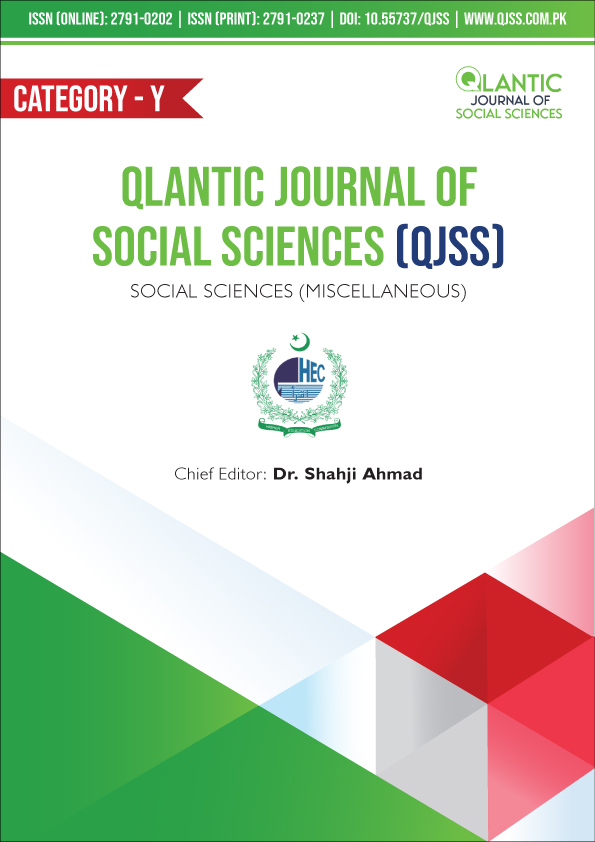Effect of Instructional Leadership Practices on Teachers' Performance at the University Level
DOI:
https://doi.org/10.55737/qjss.v-iv.24315Keywords:
Instructional Leadership, Teachers Performance, University Level, Education, Lahore Leads UniversityAbstract
The study's goal was to investigate how university-level teachers' performance was impacted by instructional leadership practices. The nature of the investigation was quantitative. The study's population comprised all 83 academic members in the humanities and social sciences. Lahore Leads University. Census sampling aims to collect information from every individual or element within the population, as the total number of faculty members was only 77. The researcher developed the questionnaire. After the demographic information, the questionnaire consisted of two parts; the first part of the questionnaire related to instructional leadership, and the second part related to Teachers' performance. The data was analyzed using SPSS (Statistical Packages for Social Sciences). Inferential statistics were used to calculate the data. The independent samples t-test was utilized to ascertain whether there was a significant difference between the demographic variables, and one-way ANOVA was utilized to investigate the differences between them in inferential statistics.
References
Akande, F. B. (2014). Assessment of the Relationship between Conditions of Service and Teachers’ Job Performance In Secondary Schools in Kogi State, Nigeria.
Blase, J., & Blase, J. (2000). Effective instructional leadership: Teachers’ perspectives on how principals promote teaching and learning in schools. Journal of Educational Administration, 38(2), 130–141. https://doi.org/10.1108/09578230010320082
Celikten, M. (2001). The instructional leadership tasks of high school assistant principals. Journal of Educational Administration, 39(1), 67-76. https://doi.org/10.1108/09578230110380742
Chen, Y.-G., & Cheng, J.-N. (2017). Exploring Differences from Principals’ Leaderships and Teachers’ Teaching Performances in Public and Private Schools. The Journal of International Management Studies, 12(2), 65–81.
Demitras, O., & Karaca, M. (2020). A Handbook of Leadership Styles. Cambridge Scholars Publishing.
Dewi, D. N., & Sowiyah. (2021). Instructional Leadership Practices in School: A Literature Review. International Journal of Current Science Research and Review, 4(10), 1326–1336. https://doi.org/10.47191/ijcsrr/V4-i10-15
Hallinger, P., & Murphy, J. (1985). Assessing the instructional management behavior of principals. The elementary school journal, 86(2), 217-247. https://doi.org/10.1086/461445
Kennedy, M. M. (2016). How does professional development improve teaching? Review of Educational Research, 86(4), 945–980. https://doi.org/10.3102/0034654315626800
Khan, Z. (2012). Relationship between Instructional Leadership and Teachers’ Job Performance in Secondary Schools in the Province of Khyber Pakhtunkhwa, Pakistan [Doctoral Dissertation]. Gomal University.
Kwan, P. (2020). Is transformational leadership theory passé? Revisiting the integrative effect of instructional leadership and transformational leadership on student outcomes. Educational Administration Quarterly: EAQ, 56(2), 321–349. https://doi.org/10.1177/0013161x19861137
Leithwood, K., Jantzi, D. and Steinbach, R. (1999). Changing Leadership for Changing Times. Open University Press, Philadelphia.
Limon, İ., & Nartgün, Ş. S. (2020). Development of teacher job performance scale and determining teachers' job performance level. Journal of Theoretical Educational Science, 13(3), 564-590.
Lyonga, N. A. N. (2018). Supervise and supervise teachers' work performances in primary schools in Konye Sub-Division in Cameroon. Journal of Educational and Social Research, 8(2), 115–124. https://doi.org/10.2478/jesr-2018-0022
Maclean, I. F. (2018). In-Service Training and Teachers Job Performance in Public Senior Secondary Schools in Rivers State. International Journal of Scientific Research in Education, 11(3B), 493–520. https://publications.afropolitanjournals.com/index.php/ajhcer/article/view/133
Mannan, F. (2017). The relationship between women principal instructional leadership practices, teacher organizational commitment and teacher professional community practice in secondary schools in Kuala Lumpur (Doctoral dissertation, University of Malaya (Malaysia).
McEwan, E. K. (2002). Seven steps to effective instructional leadership. Corwin Press.
Meyer, J. P., & Herscovitch, L. (2001). Commitment in the workplace: Toward a general model. Human resource management review, 11(3), 299-326. https://doi.org/10.1016/S1053-4822(00)00053-X
Mitchell, D. E., Ortiz, F. I., & Mitchell, T. K. (1987). Work orientation and job performance: The cultural basis of teaching rewards and incentives. SUNY Press.
Quinn, D. M. (2002). The impact of principal leadership behaviors on instructional practice and student engagement. Journal of educational administration, 40(5), 447-467. https://doi.org/10.1108/09578230210440294
Robinson, V., & Gray, E. (2019). What difference does school leadership make to student outcomes? Journal of the Royal Society of New Zealand, 49(2), 171–187. https://doi.org/10.1080/03036758.2019.1582075
Saleem, A., Aslam, S., Yin, H.-B., & Rao, C. (2020). Principal leadership styles and teacher job performance: Viewpoint of middle management. Sustainability, 12(8), 3390. https://doi.org/10.3390/su12083390
Sungu, H., Ilgan, A., Parylo, O., & Erdem, M. (2014). Examining teacher job satisfaction and principals' instructional supervision behaviours: A comparative study of Turkish private and public school teachers. Alberta Journal of Educational Research 60(1), 98-118. http://dx.doi.org/10.1037/t55587-000
Wardhana, R. A. N. (2016). The Effect Principal’s Leadership, Professionalism And Teacher Training On The Implementation Of Curriculum 2013 In SMKN Yogyakarta. Jurnal Akuntabilitas Manajemen Pendidikan, 4(2), 257–269. http://dx.doi.org/10.31851/jmksp.v7i2.12097
Whitworth, B. A., & Chiu, J. L. (2015). Professional development and teacher change: The missing leadership link. Journal of science teacher education, 26, 121-137. https://doi.org/10.1007/s10972-014-9411-2




